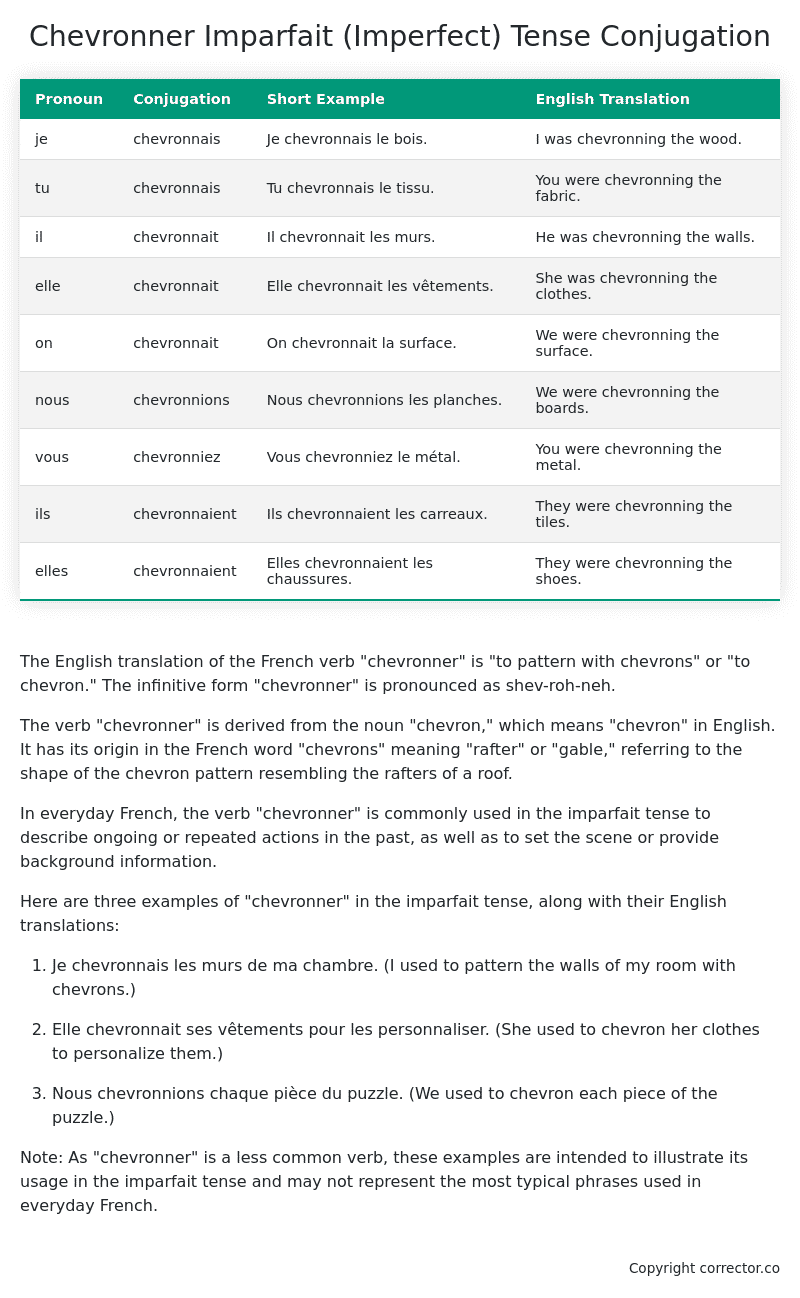Imparfait (Imperfect) Tense Conjugation of the French Verb chevronner
Introduction to the verb chevronner
The English translation of the French verb “chevronner” is “to pattern with chevrons” or “to chevron.” The infinitive form “chevronner” is pronounced as shev-roh-neh.
The verb “chevronner” is derived from the noun “chevron,” which means “chevron” in English. It has its origin in the French word “chevrons” meaning “rafter” or “gable,” referring to the shape of the chevron pattern resembling the rafters of a roof.
In everyday French, the verb “chevronner” is commonly used in the imparfait tense to describe ongoing or repeated actions in the past, as well as to set the scene or provide background information.
Here are three examples of “chevronner” in the imparfait tense, along with their English translations:
-
Je chevronnais les murs de ma chambre.
(I used to pattern the walls of my room with chevrons.) -
Elle chevronnait ses vêtements pour les personnaliser.
(She used to chevron her clothes to personalize them.) -
Nous chevronnions chaque pièce du puzzle.
(We used to chevron each piece of the puzzle.)
Note: As “chevronner” is a less common verb, these examples are intended to illustrate its usage in the imparfait tense and may not represent the most typical phrases used in everyday French.
Table of the Imparfait (Imperfect) Tense Conjugation of chevronner
| Pronoun | Conjugation | Short Example | English Translation |
|---|---|---|---|
| je | chevronnais | Je chevronnais le bois. | I was chevronning the wood. |
| tu | chevronnais | Tu chevronnais le tissu. | You were chevronning the fabric. |
| il | chevronnait | Il chevronnait les murs. | He was chevronning the walls. |
| elle | chevronnait | Elle chevronnait les vêtements. | She was chevronning the clothes. |
| on | chevronnait | On chevronnait la surface. | We were chevronning the surface. |
| nous | chevronnions | Nous chevronnions les planches. | We were chevronning the boards. |
| vous | chevronniez | Vous chevronniez le métal. | You were chevronning the metal. |
| ils | chevronnaient | Ils chevronnaient les carreaux. | They were chevronning the tiles. |
| elles | chevronnaient | Elles chevronnaient les chaussures. | They were chevronning the shoes. |
Other Conjugations for Chevronner.
Le Present (Present Tense) Conjugation of the French Verb chevronner
Imparfait (Imperfect) Tense Conjugation of the French Verb chevronner (You’re reading it right now!)
Passé Simple (Simple Past) Tense Conjugation of the French Verb chevronner
Passé Composé (Present Perfect) Tense Conjugation of the French Verb chevronner
Futur Simple (Simple Future) Tense Conjugation of the French Verb chevronner
Futur Proche (Near Future) Tense Conjugation of the French Verb chevronner
Plus-que-parfait (Pluperfect) Tense Conjugation of the French Verb chevronner
Passé Antérieur (Past Anterior) Tense Conjugation of the French Verb chevronner
Futur Antérieur (Future Anterior) Tense Conjugation of the French Verb chevronner
Subjonctif Présent (Subjunctive Present) Tense Conjugation of the French Verb chevronner
Subjonctif Passé (Subjunctive Past) Tense Conjugation of the French Verb chevronner
Subjonctif Imparfait (Subjunctive Imperfect) Tense Conjugation of the French Verb chevronner
Subjonctif Plus-que-parfait (Subjunctive Pluperfect) Tense Conjugation of the French Verb chevronner
Conditionnel Présent (Conditional Present) Tense Conjugation of the French Verb chevronner
Conditionnel Passé (Conditional Past) Tense Conjugation of the French Verb chevronner
Conditionnel Passé II (Conditional Past II) Tense Conjugation of the French Verb chevronner
L’impératif Présent (Imperative Present) Tense Conjugation of the French Verb chevronner
L’impératif Passé (Imperative Past) Tense Conjugation of the French Verb chevronner
L’infinitif Présent (Infinitive Present) Tense Conjugation of the French Verb chevronner
L’infinitif Passé (Infinitive Past) Tense Conjugation of the French Verb chevronner
Le Participe Présent (Present Participle) Tense Conjugation of the French Verb chevronner
Le Participe Passé (Past Participle) Tense Conjugation of the French Verb chevronner
Struggling with French verbs or the language in general? Why not use our free French Grammar Checker – no registration required!
Get a FREE Download Study Sheet of this Conjugation 🔥
Simply right click the image below, click “save image” and get your free reference for the chevronner imparfait tense conjugation!

Chevronner – About the French Imparfait Tense
NOTE: To take a deep dive into all the French tenses then see our article on Mastering French Tense Conjugation.
Formation of the Imparfait Tense
For regular -er verbs:
For regular -ir verbs
For regular -re verbs
Common Everyday Usage Patterns
Description of Past Habits
Background Information
Mental and Emotional States
It’s employed to express emotions, thoughts, or physical sensations in the past. For example: “J’étais content quand il est arrivé.” (I was happy when he arrived.)
Ongoing Actions
Points to Note About the Imparfait Tense
Passé Composé vs. Imparfait
Conditional
Si Clauses
Narration
I hope you enjoyed this article on the verb chevronner. Still in a learning mood? Check out another TOTALLY random French verb imparfait conjugation!


